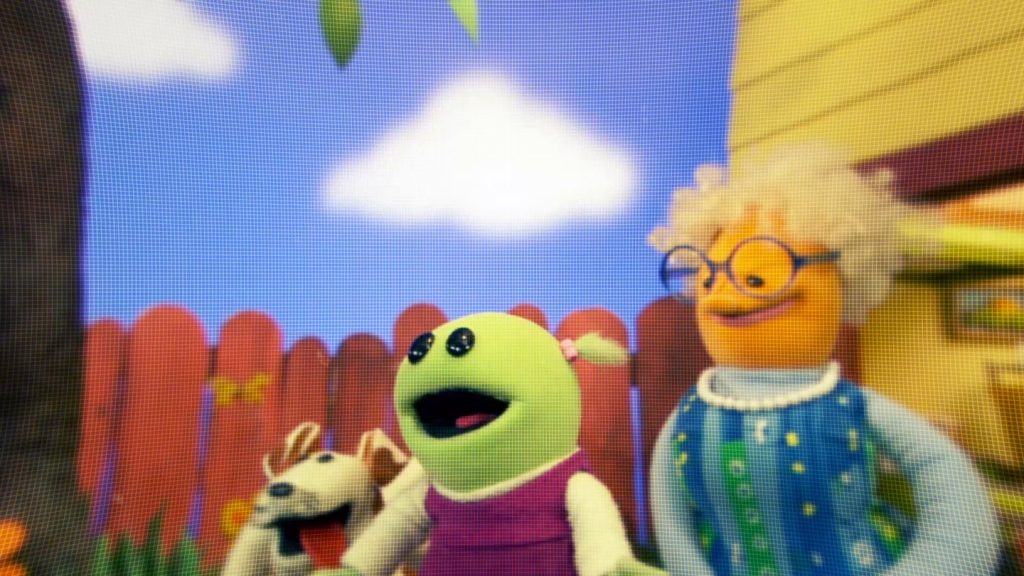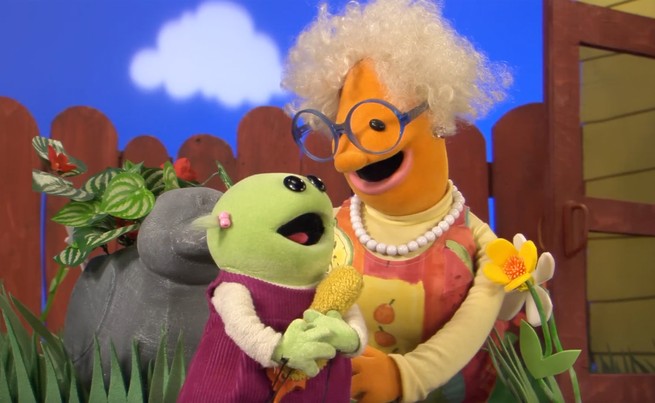‘She Is the Icon of All That Is Joyful in the World’
7 min read
Earlier this year, I was scrolling through TikTok when the sound of a piano, accompanied by a baby bird chirping, stopped my thumb mid-air. In the video, a little green puppet girl with big eyes and two tufts of hair holds a yellow felt bird in a blanket. “Hey, birdie. It’s okay, birdie,” she coos. “I’m gonna take care of you, birdie.” My mind went back to the difficult year I’d just had: the loss of my father to cancer, two consecutive layoffs from jobs I loved. But this video made me feel oddly comforted, as if I were both the girl and the bird. We were going to be okay.
After that night, I started encountering her repeatedly, via different versions of another viral clip in which she glides into a room wearing a princess costume as an older-woman puppet sings, “Who’s that wonderful girl? Could she be any cuter?” On TikTok, the video became a meme template for capturing situations in which a slightly hapless person is celebrated for the most minor of achievements, such as getting out of bed in the morning. I began singing the song to my dog.
Soon I discovered that the little girl, Mona, and her tenderhearted grandmother, Nana, come from a Canadian children’s TV series called Nanalan’ that began as a series of shorts, in 1999.The title—a portmanteau of Nana and land—refers to the backyard where Mona plays during each episode. Even though the show has been off the air for more than a decade, a new generation of adult fans is finding comfort in its depiction of childhood as a safe and nurturing time.
If many contemporary kids’ shows, such as Paw Patrol, CoComelon,and SuperKitties, are loud, fast-paced, and frankly annoying for many grown-up viewers, Nanalan’ is the opposite. The practical effects recall much older programs, such as Mister Rogers’ Neighborhood: The rods used to move the puppets’ arms are visible in each shot, large black beads take the place of eyes, and pieces of two-sided toupee tape are used to attach objects to Mona’s and Nana’s hands. The conversations between Mona and Nana are entirely improvised between the co-creators Jamie Shannon, who uses falsetto and garbled English to perfectly voice a preschooler, and Jason Hopley, whose gentle chuckles and vibrato-filled singing lend wisdom to an otherwise child-centric show.
Each episode follows the same rough structure: Mona, who is almost 3, is dropped off at Nana’s house so that her mom can go to work. Mona plays outside with Nana’s dog, Russell (or “Russer,” as she calls him). At the midpoint, Mona and Nana might go over to the neighbor’s house for a puppet show, and the day may end with a read-along or a lively song and dance. There are no magical quests, no special effects, no overt moral lessons that a character preaches into the camera. Instead, Mona learns by experience: the joy of blowing bubbles into a glass of milk or watching butterflies outside, guilt over breaking Nana’s prized statue and blaming the dog.
More than a decade after parting ways, the creators reconnected due to what they describe as the “Nanalution.” (Yes, that’s Nanalan’ and revolution.) Although the show was originally created with an audience of small children in mind, the Nanalution has reached nearly half a million followers on both TikTok and Instagram. In fact, the program’s audience is largely Millennial women from the U.S., according to the research and analytics division for the United Talent Agency, which represents Hopley and Shannon.
“The world seems a bit smaller and a little bit sadder or more tense,” Hopley told me of why he thinks a ’90s children’s show is resonating with older audiences now. “Nanalan’ seems to answer some kind of wonderful need for people to feel safe, comfort, and unconditional love.” This was essentially the show’s goal from its inception, Shannon told me. But in recent months, Nanalan’ fans have latched on to the Jungian concept of the “inner child,” seeing Mona and Nana as a balm for their own unaddressed aches. The phrase “heal your inner child” has now become the tagline for Nanalan’ on social media.

Brooke Dumain, a clinical social worker and a therapist, explained to me that childhood trauma can manifest when a primary attachment figure, such as a parent, fails to attend to a child’s “emotional needs.” The child doesn’t have the space or proper tools to explore and process difficult feelings, such as loneliness, anger, and shame. But Nanalan’ is full of scenes demonstrating what happens when children receive the support they need, such as when Nana comforts a sobbing Mona after the little girl admits that she lied about the dog breaking Nana’s beloved statue. Nana assures Mona that she can confide in her about anything, even if she’s in the wrong. Nana doesn’t excuse Mona’s behavior, but she gently guides her granddaughter toward the right path without ever raising her voice. Mona, without overtly being told, also comes to terms with her guilt about the dog being punished in her stead, culminating in her confession of wrongdoing to Nana. “So much of inner-child work is around reparenting in a certain way so that you’re … allowing yourself to experience hard emotions and, as the adult now, saying to that little kid, ‘This is okay; this is what’s happening to you,’” Dumain said of this particular mode of therapy.
Although other children’s shows may have characters contend with similar emotions, Nanalan’ stands out for the simplicity of its conceit. Thanks to Mona’s minimal facial features, her puppetness allows viewers to more easily project themselves onto her, Shannon explained. The universality of her experiences—accidentally damaging a favorite toy, learning to cope with the end of good things—lends a certain timelessness to Nanalan’. When conceiving of the show, the creators asked themselves, What is it that a child is going through at that time in their life? “They’re the center of the universe, and everything is remarkable … There’s a spider web you could look at for hours,” Hopley told me. “It’s that kind of experiential life that Mona has. She’s that curious. She is the icon of all that is joyful in the world.”
If Mona is the archetypal child, then Nana is the de facto moral compass and the ideal adult in the room. When Russell spills milk all over Mona’s dress, Nana is there to help Mona identify her emotions—“Are you feeling mad? Are you feeling kind of sad?”—and take some deep breaths to cope. She reassures Mona (and the dog) that the spilled milk was simply an accident, and helps Mona put on a clean dress. “Nana exists to literally let Mona be who she is with support and love and guidance,” Hopley said.
The “mad and sad” scene is another viral Nanalan’ clip, in part thanks to the funny noises Mona makes when she responds to Nana’s questions. (The McLaren racing team even got in on the joke.) The irony of a slower-paced children’s show finding newfound popularity on TikTok and Instagram, where a user will scroll by a video in mere seconds, is not lost on the two creators. With a core team of just three, including their social-media manager, Shannon and Hopley keep up with demand by regularly posting snippets of the show and hosting live videos on TikTok and Instagram, as well as releasing full episodes on YouTube.
In addition to comments praising the show for its healing nature, Shannon and Hopley see the tangible impact that Mona and Nana have on viewers through Cameo, the marketplace that allows fans to pay for a personalized video from their favorite celebrity. Although they’ve fielded a number of event-oriented requests—marriage proposals, Valentine’s Day and birthday messages—the duo say their most common requests are for pep talks for viewers going through a rough period, such as grieving the death of a pet. The work can be emotionally taxing, with Shannon and Hopley receiving as many as 40 requests a day (for videos that cost $125 to $175 a pop). For them, these requests show the extent of their fans’ connection with Mona and Nana. “In production, you make a show, and you send it off to the world, and you don’t really hear much back,” Hopley told me. “But for Cameos, you are directly being asked to help somebody.”
As for the future of Nanalan’,the two creators’ sights have turned to Hollywood: Recently signed by agents at United Talent Agency, Shannon and Hopley are looking toward expansions such as a TV special and an album with new music. One of their agents, Emily Miller, told me that part of the appeal of Nanalan’ was that it’s a low-cost but already proven project “in a TV landscape where budgets are so high and buyers don’t want to take risks on super, super expensive things like Lord of the Rings.”
In transcending its target audience of preschoolers, Nanalan’ could go on to have an outsize presence in the rich history of children’s programming. Like the Australian animated show Bluey, which follows a family of heeler dogs through everyday parent-child scenarios (and has since turned into a $2 billion franchise), Nanalan’ demonstrates how simple storylines can resonate with contemporary audiences by offering an outlet for their most childlike emotions. Put simply, life is full of joy and full of sorrow; one year could be marked by big achievements, followed by another of major losses and disappointments. Even if we don’t have our own Nanas to guide us, a show like Nanalan’ is there to help remind us that what we feel is valid, even when there are things outside our control. Like Mona and her birdie, we can learn to be okay.



